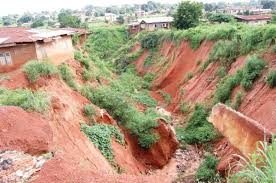Prof James Adediran, the Executive Director, Institute of Agricultural Research and Training (IAR&T), Ibadan, says IAR&T has developed an erosion-control method, using Vetiver grass.
Adediran made this known in an interview with News Agency of Nigeria (NAN) on Friday in Ibadan.
He said that Vetiver is a densely tufted, wiry, perennial grass with strong fibrous root system that can penetrate and bind the soil to a depth of up to three meters.
The professor said that the grass has stiff, erect stems that can form dense hedges against erosion.
Adediran added that the use of the grass for erosion control stood the test of time, compared with other trees.
He explained that apart from being perennial grass that required minimal maintenance, its crown was below the surface, which ensured the safety of the plant against fire and overgrazing.
He said “Vetiver grass doesn’t compete with other crops at establishment; it’s cheap, easy to establish as hedgerows in any farming systems, it has sharp leaves,
aromatic roots, repel rodents, pests in all types of soil and wide range of climate on which it can grow.
“Its application to erosion control doesn’t require engineering skills, as farmers can do the whole job themselves.”
The executive director said that planting the grass slips should be at the beginning of rainy season, to ensure they got full benefits of the rains.
He added that “farmers should dig a shallow hole in ploughed furrow to mark the contour furrow, otherwise the slips would not quickly form dense hedges; the slips could withstand up to one month of dry weather if planted correctly.
“Fill the gap in the hedge line by planting new Vetiver grass slips if some slips die; this ensures that the grass strips forms dense hedges across the slope and stand as barriers against soil loss and runoff.
“At the early stage when the slips are just planted, apply phosphate fertiliser such as di-ammonium phosphate at 150 kg/ha (75g/10m strip), it encourages fast tillering and helpful in the nursery and field.”
According to him, prunnings from Vetiver hedges can be used as mulch material or for compost making, thus relieving farmers of the problem of getting mulch materials elsewhere.
Adediran said that among different land degradation processes, erosion remained a major threat to the conservation of soil and water on farmers’ field.
“The method of using Vetiver hedgerows will, therefore, assist farmers to tackle soil erosion, thus replacing the old traditional earthen bonds,” he said. (NAN)


